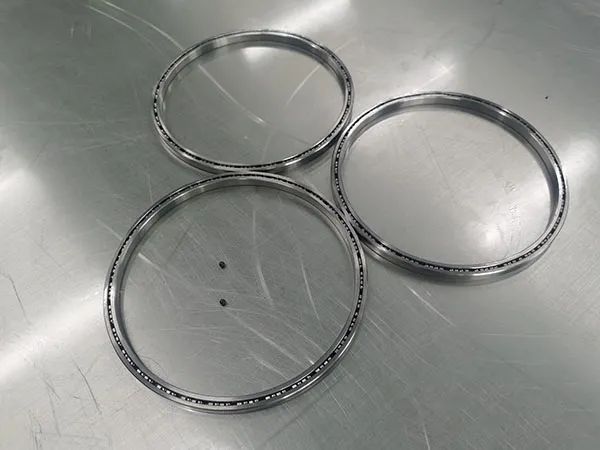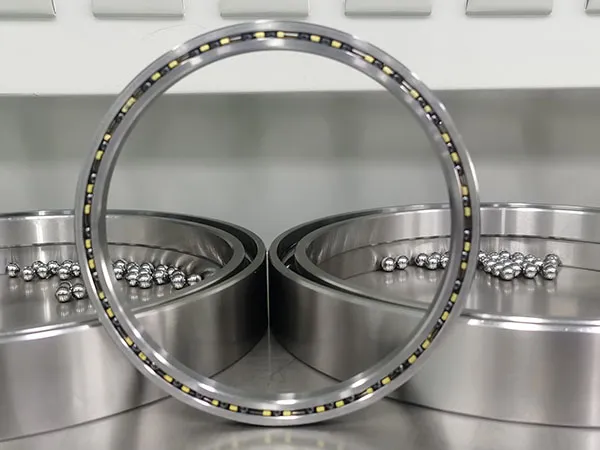Thin section bearings, characterized by their small and constant cross-section regardless of bore diameter, are designed for applications where space and weight are critical. Within this category, a key distinction lies between sealed and open bearings, primarily concerning their protection against the environment and lubrication management.

Sealed Thin Section Bearings: These bearings have integrated seals (typically made of rubber or other elastomeric materials) that create a barrier, preventing dirt, dust, moisture, and other contaminants from entering the bearing's internal components.
Advantages:
Excellent Contamination Prevention: Ideal for harsh, dirty, or wet environments.
Extended Bearing Life: By keeping contaminants out, wear and damage are significantly reduced.
Reduced Maintenance: Often "lubricated for life" and do not require re-lubrication, leading to lower maintenance costs and less downtime.
Lubricant Retention: The seals effectively retain the internal lubricant (usually grease), ensuring consistent lubrication and preventing degradation.
Disadvantages:
Higher Friction: The contact between the seals and the rotating components can generate more friction, potentially leading to slightly higher operating temperatures and limiting maximum speeds.
Higher Initial Cost: The manufacturing process for integrating seals adds to the initial cost.
Limited Accessibility for Inspection/Maintenance: The seals make it difficult to access the internal components for inspection or troubleshooting. If the internal lubricant degrades, the bearing typically needs to be replaced rather than re-lubricated.
Potential for Seal Failure: Seals can wear and degrade over time, especially in demanding conditions, leading to potential contamination ingress if they fail.
Open Thin Section Bearings: These bearings do not have seals or shields, leaving their internal components exposed to the environment. They are typically used where the bearing is immersed in a lubricating fluid or in very clean, controlled environments.
Advantages:
Lower Friction/Higher Speeds: Without the drag of seals, open bearings generally have lower rotational torque and can operate at higher speeds.
Lower Initial Cost: Simpler manufacturing leads to a lower upfront cost.
Flexibility in Lubrication: Allows for different types of lubricants to be used and facilitates re-lubrication as needed.
Easier Inspection: Internal components are easily accessible for visual inspection.
Disadvantages:
Vulnerable to Contamination: Highly susceptible to ingress of dirt, dust, moisture, and other foreign particles, which can rapidly lead to wear and premature failure.
Requires Regular Lubrication: Needs frequent re-lubrication, increasing maintenance costs and potential for downtime.
Shorter Lifespan in Harsh Environments: Not suitable for dirty or wet conditions due to lack of protection.

Sealed Bearings: Typically pre-lubricated with grease and designed to be "lubricated for life," meaning they generally don't require additional lubrication throughout their operational lifespan.
Open Bearings: Require external lubrication, often by being immersed in oil or by regular application of grease.
Sealed Bearings: Best suited for applications in harsh, contaminated, or wet environments where maintenance is difficult or undesirable. Common in automotive, industrial machinery, and agricultural equipment.
Open Bearings: Preferred in clean, controlled environments where high speed and low rotational torque are critical, or where the bearing is continuously lubricated by a system. Examples include some household appliances or specialized machinery in cleanrooms.
The choice between sealed and open thin section bearings depends heavily on the specific application's environmental conditions, speed requirements, maintenance accessibility, and cost considerations. Sealed bearings offer superior protection and reduced maintenance at a higher initial cost and potentially lower maximum speeds, while open bearings provide lower friction and cost but demand a cleaner environment and more frequent maintenance.
Thin Section Bearing Failure Analysis and Practical Solutions for Long-Term Reliability
2026-01-09 11:37Effects of Surface Roughness on Slewing Bearing Performance
2025-12-27 17:21A Comprehensive Analysis of Slewing Bearing Manufacturing Process: Materials, Procedures, and Detailed Precision Machining Steps
2025-12-15 16:30How to Improve the Surface Brightness of Slewing Bearings? 5 Effective Methods to Enhance Performance and Durability
2025-12-11 15:36Address: Lianmeng Road, Jianxi district, Luoyang City,Henan province.
E-mail: info@lynicebearing.com
Phone: +86-379-60689957
If you are interested in our products and services,
please feel free to contact us!
Get in tuch

+86-379-60689957
Lianmeng Road, Jianxi district, Luoyang City,Henan province.